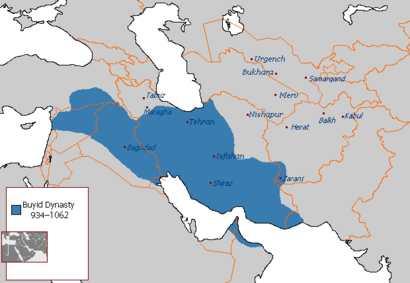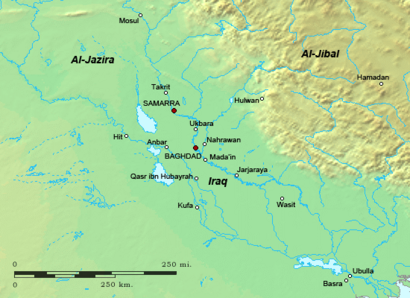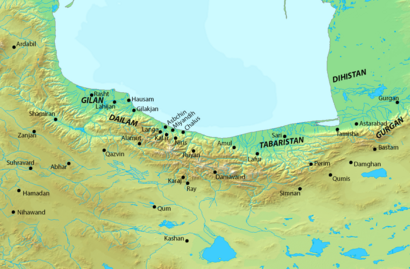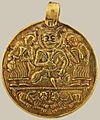'Adud al-Dawla facts for kids
Quick facts for kids Adud al-Dawla |
|
|---|---|
| King of Kings (Persian: Šāhanšāh) |
|

Medallion of Adud al-Dawla
|
|
| Emir of Fars | |
| Reign | 949–983 |
| Predecessor | Imad al-Dawla |
| Successor | Sharaf al-Dawla |
| Emir of Kerman | |
| Reign | 967–983 |
| Predecessor | Mu'izz al-Dawla |
| Successor | Sharaf al-Dawla |
| Emir of Iraq and Jazira | |
| Reign | 978–983 |
| Predecessor | Izz al-Dawla |
| Successor | Samsam al-Dawla |
| Born | September 24, 936 Isfahan |
| Died | March 26, 983 Baghdad |
| Burial | Najaf |
| Consort | Sayyida bint Siyahgil |
| Issue | Sharaf al-Dawla Samsam al-Dawla Baha' al-Dawla Shahnaz |
| House | Buyid |
| Father | Rukn al-Dawla |
| Mother | Firuzanid noblewoman |
| Religion | Shia Islam |
Fannā (Panāh) Khusraw (Persian: پناه خسرو), better known as ʿAḍud al-Dawla (Arabic: عضد الدولة), was a powerful ruler (called an emir) of the Buyid dynasty. His name, Adud al-Dawla, means "Pillar of the [Abbasid] Dynasty." He ruled from 949 to 983.
At the peak of his power, his empire stretched from Makran (a region in modern-day Iran and Pakistan) to Yemen and the Mediterranean Sea. Many people consider him the greatest ruler of the Buyid dynasty. By the end of his reign, he was the most powerful leader in the Middle East.
Adud al-Dawla was the son of Rukn al-Dawla. He received the title of Adud al-Dawla from the Abbasid caliph in 948. This happened when he became the emir of Fars after his uncle, Imad al-Dawla, passed away without children. Later, his father, Rukn al-Dawla, became the most important Buyid emir.
In 974, Adud al-Dawla helped his cousin, Izz al-Dawla, who was facing a rebellion. After winning, Adud al-Dawla took control of Iraq and made his cousin step down. However, his father was upset by this and put Izz al-Dawla back in charge. After his father died, his cousin rebelled again, but Adud al-Dawla defeated him. Adud al-Dawla then became the sole ruler of the Buyid dynasty. He took the old Iranian title of Shahanshah, which means "King of Kings."
When Adud al-Dawla became the emir of Iraq, its capital city, Baghdad, was experiencing a lot of violence. To bring peace, he banned public protests and arguments. At the same time, he supported many Shia scholars and helped fix important Shia holy places.
Adud al-Dawla also supported science and building projects. He ordered an observatory to be built in Isfahan, where the famous astronomer Azophi worked. He also ordered the construction of a large dam between Shiraz and Istakhr in 960. This dam, known as Band-e Amir, helped water about 300 villages in Fars province. Another big project was digging the Haffar channel, which connected the Karun river to the Shatt al-Arab river. The port of Khorramshahr was built on the Haffar.
Contents
Becoming a Ruler
Fanna Khusraw was born in Isfahan on September 24, 936. His father was Rukn al-Dawla. His mother was the daughter of a nobleman named al-Hasan ibn al-Fairuzan.
In 948, his uncle, Imad al-Dawla, chose Fanna Khusraw to be his successor because he had no children. When Imad al-Dawla died in December 949, Fanna Khusraw became the new ruler of Fars. Some military officers did not like this and rebelled against him. His father, Rukn al-Dawla, quickly went to southern Iran to help his son. They defeated the rebels and placed Fanna Khusraw on the throne in Shiraz.
Fanna Khusraw wanted the title "Taj al-Dawla" (Crown of the state) from the Abbasid caliph. But another powerful Buyid ruler, Mu'izz al-Dawla, thought this title meant Fanna Khusraw was superior. So, they chose a different title: "Adud al-Dawla" ("Pillar of the Abbasid dynasty"). Adud al-Dawla was only thirteen when he became the ruler of Fars. He was taught by his tutor, Abu 'l-Fadl ibn al-'Amid.
After Imad al-Dawla died in 949, Adud al-Dawla's father, Rukn al-Dawla, became the most powerful Buyid ruler. In 955, a military officer took Isfahan from Rukn al-Dawla. Adud al-Dawla marched to the city and took it back. He also helped put down other rebellions.
In 966, Adud al-Dawla and Mu'izz al-Dawla worked together to bring Oman under Buyid control. The next year, Mu'izz al-Dawla died, and his son, Izz al-Dawla, became the emir of Iraq. Adud al-Dawla also helped Bisutun become the ruler of the Ziyarid kingdom. Adud al-Dawla and Bisutun then formed an alliance, with their children marrying each other.
Expanding the Empire

In 967, Adud al-Dawla took advantage of a conflict in Kerman to add the province to his lands. He appointed his son, Shirdil Abu'l-Fawaris, to govern Kerman.
The next year, Adud al-Dawla made peace with the Saffarid ruler, Khalaf ibn Ahmad. Khalaf agreed to recognize Buyid authority. In 969/970, a son of the former Kerman ruler tried to take back the region, but Adud al-Dawla defeated him. Adud al-Dawla continued to expand his lands all the way to the strait of Hormuz. Many Iranian tribes converted to Islam and supported him during his campaigns.
In 971, Adud al-Dawla led an expedition against the Baloch tribes who had declared independence. He defeated them in January 972 and put loyal landowners in charge. After this, Adud al-Dawla and his father signed a peace treaty with the Samanids, paying them 150,000 dinars. In the same year, Adud al-Dawla conquered most of Oman, including its capital, Sohar.
Challenges and Victories
In 974, Adud al-Dawla's cousin, Izz al-Dawla, was trapped by his own rebellious troops in Wasit. Adud al-Dawla quickly left Fars to stop the rebellion. He won a major victory against the rebels in January 975. Adud al-Dawla then forced Izz al-Dawla to step down on March 12, 975.
His father, Rukn al-Dawla, was very angry about this. He told Adud al-Dawla that Izz al-Dawla's family could not be removed from power. Adud al-Dawla tried to make up with his father by offering him money, but Rukn al-Dawla refused. He then put Izz al-Dawla back as the ruler of Iraq. This disagreement later led to a war between Izz al-Dawla and Adud al-Dawla after Rukn al-Dawla died.
In 975, Adud al-Dawla also launched an expedition to take Bam. He defeated another son of the former Kerman ruler who was trying to get Kerman back.
War for Iraq
On September 16, 976, Rukn al-Dawla died. After his death, Izz al-Dawla prepared to get revenge on Adud al-Dawla. He formed alliances with his brother, Fakhr al-Dawla, and other rulers in northern and southern Iraq. However, Mu'ayyad al-Dawla, another brother of Adud al-Dawla, remained loyal to him.
Izz al-Dawla stopped recognizing Adud al-Dawla's rule and removed his name from Friday prayers. Adud al-Dawla was very angry. He marched towards Khuzestan and easily defeated Izz al-Dawla in Ahvaz on July 1, 977. Izz al-Dawla asked Adud al-Dawla for permission to retire in Syria. However, on his way to Syria, Izz al-Dawla was convinced by Abu Taghlib, the ruler of Mosul, to fight Adud al-Dawla again. On May 29, 978, Izz al-Dawla and Abu Taghlib attacked Adud al-Dawla near Samarra. Izz al-Dawla was defeated again, captured, and executed by Adud al-Dawla's orders.
Adud al-Dawla then captured Mosul, forcing Abu Taghlib to flee. Adud al-Dawla spent a year in Mosul to strengthen his power. His army also conquered Diyar Bakr and Diyar Mudar. The important city of Mayyafariqin was soon captured. Adud al-Dawla gained complete control of the region.
Adud al-Dawla, now the ruler of Iraq, also took control of lands held by Bedouin and Kurdish tribes. He appointed Badr ibn Hasanwayh as the ruler of the Hasanwayhid dynasty. He also fought against other local rulers. During this time, Adud al-Dawla had Izz al-Dawla's former chief minister arrested and executed.
Control of Northern Iran
Around this time, Bisutun died, and his kingdom faced a civil war. Adud al-Dawla sent an army to help Bisutun's brother, Qabus, against Bisutun's son. Qabus won and captured Bisutun's son. Adud al-Dawla then had the Abbasid caliph give Qabus the title of Shams al-Ma'ali.
In May 979, Adud al-Dawla invaded the lands of his brother, Fakhr al-Dawla. Fakhr al-Dawla had to flee, and many of his soldiers left him. Adud al-Dawla then moved to Kerman and later Kermanshah, where he set up a governor. In August/September 980, Adud al-Dawla captured Hamadan.
Soon after, Adud al-Dawla's younger brother, Mu'ayyad al-Dawla, sent his chief minister to negotiate a transfer of power. Adud al-Dawla recognized his loyal younger brother. He gave Mu'ayyad al-Dawla Fakhr al-Dawla's troops and helped him conquer Tabaristan and Gorgan from Qabus, who had betrayed Adud al-Dawla. Mu'ayyad al-Dawla quickly conquered these two provinces.
A Strong Empire and Peace Talks
Adud al-Dawla was now the most important ruler of the Buyid Empire. Many other rulers, including the Hamdanids, Saffarids, and even those in Yemen, recognized his authority. Other regions, like Makran, were also under Buyid control.
Adud al-Dawla returned to Baghdad, where he built and repaired many buildings. He also stopped conflicts between different groups in the Buyid army. In 980, a Byzantine rebel named Bardas Skleros fled to Mayyafariqin. He offered to ally with Adud al-Dawla against the Byzantines, which Adud al-Dawla accepted. A Byzantine messenger from Constantinople arrived in Baghdad, asking Adud al-Dawla to hand over the rebel. But Adud al-Dawla refused, keeping the rebel in Baghdad. This helped him in his diplomatic talks with the Byzantines.
In 981, Adud al-Dawla sent an envoy to Constantinople to discuss peace. He was likely also trying to gather information about the Byzantine military, as he planned to invade their territory. In 982, Adud al-Dawla sent another envoy, who signed a 10-year peace treaty with the Byzantines. One year later, a Byzantine envoy came to Baghdad, but Adud al-Dawla was too sick to finish the talks. The 10-year peace treaty was finally completed. The Byzantines even agreed to mention Adud al-Dawla's name in their Friday prayer in Constantinople.
Administration and Contributions

Adud al-Dawla usually held his court in Shiraz. He often visited Baghdad and had some of his chief ministers there, including a Christian named Nasir ibn Harun. He also had several Zoroastrian officials who served him. Adud al-Dawla seemed to respect their religion greatly.
Under his rule, the Buyid kingdom thrived. His policies were fair, and there were no major riots. He made Baghdad beautiful with many public buildings, including the famous al-'Adudi Hospital. This was the largest hospital of its time, and many important doctors worked there.
Adud al-Dawla also built rest stops (called caravanserais) and dams. Shiraz especially benefited from his work. He built a palace there with 360 rooms and advanced wind towers for air conditioning. The population of Shiraz grew so much that he built a new city nearby for his army. This city was called Kard-i Fannā Khusraw, meaning "made by Fanna Khusraw." This name was similar to how the Sasanians named their cities.
Shiraz had two yearly festivals during his reign. One celebrated when water pipes reached the city, and the other was for the city's founding anniversary. Adud al-Dawla started these celebrations based on the Iranian New Year holiday, Nowruz.
All these activities greatly boosted the economy of Fars. The tax income tripled in the 10th century. His contributions made Fars a stable and prosperous region for culture of Iran during later invasions.
Family Life
To keep peace, Adud al-Dawla arranged marriages with other rulers. His daughter married the Abbasid caliph at-Ta'i, and another daughter married a Samanid ruler and the Ziyarid ruler Bisutun. Adud al-Dawla himself had several wives. These included the daughter of Bisutun, a Justanid king's daughter, and a Giilite king's daughter.
Adud al-Dawla had several sons. His son, Abu Kalijar Marzuban, was chosen as his heir because of his important family background.
Death and Succession
Adud al-Dawla died in Baghdad on March 26, 983. He was buried in Najaf. His son, Abu Kalijar Marzuban, who was in Baghdad, kept his father's death a secret at first. This was to make sure he could become the next ruler and avoid a civil war. When he announced his father's death, he was given the title "Samsam al-Dawla." However, Adud al-Dawla's other son, Shirdil Abu'l-Fawaris, challenged Samsam al-Dawla's rule, which led to a civil war.
Legacy

Adud al-Dawla, like earlier Buyid rulers, kept the Abbasid caliphs in Baghdad. This helped make his dynasty seem legitimate to some Sunni Muslims. However, he was more interested in Iran's pre-Islamic culture than his predecessors. He was proud of his Iranian background. He visited Persepolis with a Zoroastrian high priest, who read the old inscriptions for him. Adud al-Dawla later left his own inscription there, showing he knew he was part of an ancient pre-Islamic civilization. He even claimed to be a descendant of the Sasanian king Bahram V Gor. He minted coins showing himself wearing a Sasanian-style crown, with the traditional Sasanian inscription, Shahanshah, may his glory increase.
Even though he admired ancient Iranian culture, he seemed to prefer Arabic writers over Persian ones. He spoke Arabic, wrote in Arabic, and was proud to have studied with a famous Arab grammarian. He studied science, including astronomy and mathematics, in Arabic. Many books in Arabic, both religious and non-religious, were dedicated to him.
Adud al-Dawla did not feel that his admiration for pre-Islamic Iranian culture conflicted with his Muslim Shiite faith. Some stories say he repaired the Imam Husayn Shrine in Karbala and built a mausoleum for Ali in Najaf, which is now known as the Imam Ali Mosque. He was known to be generous to a famous Shiite religious scholar. He was also tolerant of Sunnis. He even tried to get closer to the Sunnis by offering his daughter in marriage to the caliph, but the caliph refused to complete the marriage.
Images for kids
See also
 In Spanish: Adud al-Dawla para niños
In Spanish: Adud al-Dawla para niños




